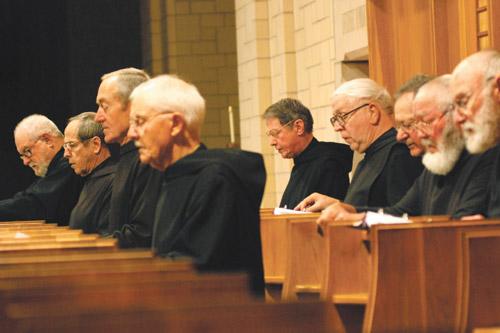
Subiaco Abbey launched an $8-million capital campaign June 1 to provide for the future of older monks, young monks in formation and students at its seventh-through-12th-grade boys’ academy.
Abbot Jerome Kodell, OSB, said the necessity for the fundraising campaign became apparent over the past several years after the abbey worked with the National Religious Retirement Organization at the U.S. Conference of Catholic Bishops to assess what Subiaco Abbey needs to care for its elderly and infirm monks.
Committees were established to look at needs at the abbey and academy, followed by a feasibility study, funded by the NRRO, in which donors were asked if they would support the projects. The response was positive and NRRO awarded the abbey a significant grant to hire consultants and conduct the campaign. Alumnus Steve Schmitz of Gainesville, Texas, was appointed the campaign chairman.
“Continuing the Tradition: A Campaign for Subiaco” was created to raise money for four areas:
The abbey has a health center where three monks live today, but on average there are five to six monks there. Their monks’ average Social Security income is only $448 a month, and it costs the abbey an additional $2,000 a month to care for a monk over 70 years old.
The Retirement for Religious Fund gave the abbey $33,360.93 in 2012 for its elderly monks. It reported then that 95.19 percent of Subiaco’s future retirement needs were unfunded, one of the highest percentages in the country.
Subiaco Abbey has 33 monks and 10 men in formation. On average, it costs $25,000 to $30,000 a year to educate a seminarian.
In order to attract more students to the academy, the abbey wants to renovate its 100-year-old main residence hall to convert it into classrooms and offices and build a new 10,000-square-foot gathering space with a dormitory on the second floor, which will be called Fuhrmann Hall.
“A lot of the kids are in the main building and we would like to have that space back for more classrooms and then also as we try to recruit new students it would be helpful to have a nice, new dorm building,” Schmitz said.
The abbey plans to upgrade the academy’s performing arts center and build new tennis courts. The abbey would also like to spend $150,000 to buy or build faculty housing to attract and retain high-quality teachers.
Coury House, the abbey’s retreat center, was expanded in 2005, but new windows are needed throughout the building. The abbey also needs to update technology and communications.
In an interview with Arkansas Catholic, Schmitz said the abbey has already raised $4.9 million from alumni and donors over the past 12 months to get the campaign past the halfway mark even before the official launch, which was held in conjunction with the school’s annual alumni reunion.
Schmitz said the campaign will continue through March 2014.
In a letter to donors, Bishop Anthony B. Taylor offered his “unconditional support” to the campaign. His grandparents and mother were served by Subiaco monks while they attended St. Mary of the Assumption Church in Fort Worth, Texas, in the 1940s. His father was educated at Laneri High School, also in Fort Worth, where the monks once taught. His parents were married by Subiaco monk Father Meinrad Marbaugh, OSB, at St. Mary.
“Little did the monks know at the time that in serving my family and nurturing my parents’ faith, they had a hand in remote formation of the man who would one day be their bishop,” the bishop wrote.
Having lived at Subiaco for four years, Schmitz, a 1991 graduate and president of an investment firm, said the academy generates a lot of admiration and dedication from its alumni.
“Subiaco, it’s really more than a high school,” he said. “It’s your family. To me it doesn’t feel any different than doing something for your family … My classmates, I talk to them all the time. They are like brothers. You live with them and they become so much a part of your life for four years. I still talk to some of the faculty and staff who were there 25 years ago.”
Please read our Comments Policy before posting.
Article comments powered by Disqus Don’t let misconceptions cause faith to waver
Don’t let misconceptions cause faith to waver
 Seniors, whatever storms may come, Jesus will be there
Seniors, whatever storms may come, Jesus will be there
 Studio 3:16 offers new approach to teaching religion
Studio 3:16 offers new approach to teaching religion
 After three decades, NLR principal plans to retire
After three decades, NLR principal plans to retire
 CHS athlete overcomes odds to reach collegiate goal
CHS athlete overcomes odds to reach collegiate goal
 St. Joseph a model of solidarity with immigrants
St. Joseph a model of solidarity with immigrants
 Two gifts after Jesus’ death: Virgin Mary and Eucharist
Two gifts after Jesus’ death: Virgin Mary and Eucharist
 Why we have an altar, and not just a communion table
Why we have an altar, and not just a communion table
 Pope: Wars should be resolved through nonviolence
Pope: Wars should be resolved through nonviolence
 Living relationship with Jesus Christ in the Eucharist
Living relationship with Jesus Christ in the Eucharist